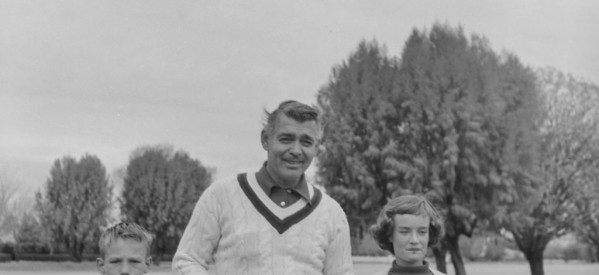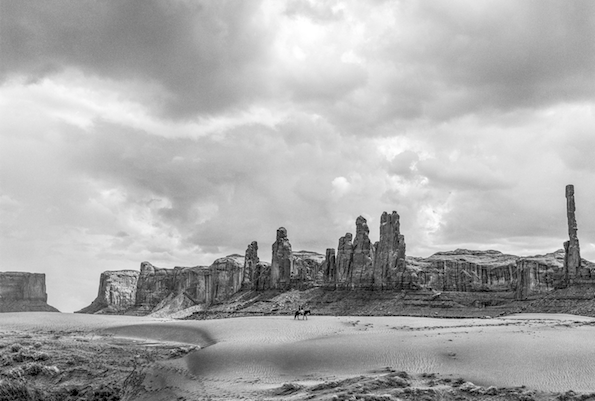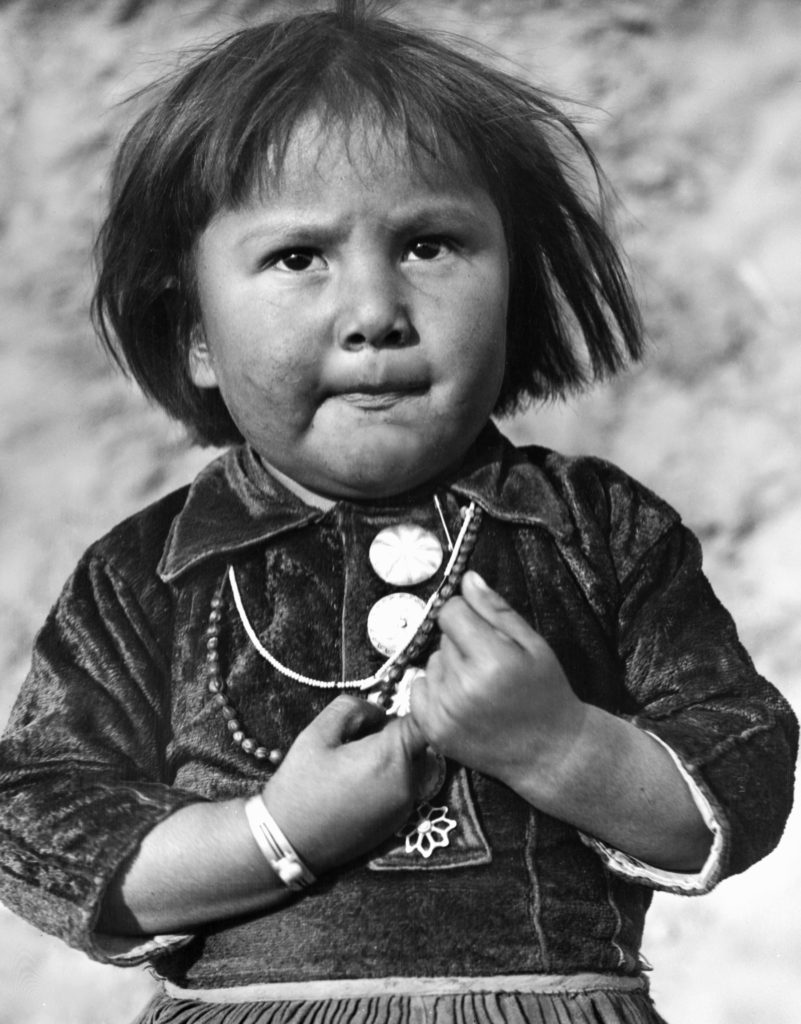Frozen in Time

Exhibit of Barry Goldwater’s photos captures rarely seen sides of Arizona
By Niki D’Andrea
Ali Goldwater remembers flying in a plane over the Grand Canyon with William F. Buckley, Jr. and her grandfather, Barry Goldwater, when she about 5 years old.
“We flew up there, and he would always have a camera,” she recalls. “He usually had a couple cameras with him, because he’d be shooting black and white and color. So at an early age, I remember just traveling around the state with him, and we usually flew in an airplane or a helicopter. I couldn’t vote but I worked for him. I got to travel with him around the state when he gave speeches and whatnot.”
Though he’s known internationally as the late five-term U.S. Senator from Arizona and Republican nominee for U.S. President in the 1964 election, Barry Goldwater was also an archivist of Arizona history. To a large extent, he is Arizona history. Little Barry Goldwater was the ring-bearer at the first wedding held after Arizona’s statehood in 1912 – an event he recounted in 1978 for the Arizona History Project: “I remember I was only about 4 years old, standing outside waiting for the telegraph boy to bring a message saying that President Taft had signed us into statehood. It was Joe Meltzer’s determination to be the first man married in the State of Arizona. Sure enough, I can still see that dust coming up old unpaved First Avenue with the messenger with the telegram.”
In adulthood, Goldwater would have captured that dust being kicked up into the air on camera. Over the course of his life, he took more than 15,000 photographs, and the vast majority of them capture snapshots of a lost Arizona: vistas of untamed wilderness; detailed close-ups of desert flora; action shots of wild horses; candid photos of Native American children.
An extensive selection of Goldwater’s photographs are on display in the exhibit Photographs by Barry Goldwater: The Arizona Highways Collection at Western Spirit: Scottsdale’s Museum of the West (SMoW).
Ali Goldwater has been working for years to preserve and digitize her grandfather’s photos for the Barry & Peggy Goldwater Foundation, which she founded in 2018. “This has been a dream of mine for many years,” says Goldwater, who gathered negatives and photos from fellow family members as well as institutions throughout the U.S. that housed part of her grandfather’s body of work. “Initially, a few years ago, I started visiting the directors of these institutions and talking to them about the collection and what I wanted to do, and they were all on board, but they also kind of looked at me and said, ‘Wow, you’re really going to do that? Because there’s 15,000 (photos).’”

Photographs by Barry Goldwater: The Arizona Highways Collection is the first all-photo solo exhibition at SMoW. “The community of Scottsdale couldn’t be prouder than to feature as its first one-person photography show the work of a highly distinguished native Arizonan, Paradise Valley resident and a U.S. Senator of Arizona,” says Dr. Tricia Loscher, assistant museum director of collections, exhibitions and research at Western Spirit.
“Barry Goldwater was a multi-faceted and complex person,” Loscher continues. “His abilities as a businessman were evident as head of a family-owned department store; an avid outdoorsman, he was one of the first people known to shoot the rapids of the Colorado River; a five-term U.S. Senator, his eminence as a political figure looms large as he helped lead the country to preserve and be caretakers of all the best in our nation’s history.”
In addition to capturing lost eras in Arizona, Goldwater also had access to places in the state most people couldn’t casually visit, including Native American reservations, where Goldwater was a frequent visitor and a friend. “I remember one time going up to the Navajo Nation and being in the auditorium,” Ali recalls. “And I was watching (my grandfather) there and him speaking, and he had a great turnout. It was just really interesting to see how receptive they were, and the reception that he got from the Navajo people.”
“Not many people were able to capture the different tribes of Arizona like my grandfather,” she adds. “Because he did have their respect and he respected them tremendously. He spent a lot of time on the different reservations.”
In addition to Goldwater’s photos, the exhibition will include some of his personal items, including one of his camera cases, which he wrote “Goldwater” on with a Sharpie.
Also as part of the exhibition, which runs through June 23, the museum hosted the event “Growing Up Goldwater” on January 30. Ali Goldwater and several other members of the Goldwater family were in attendance to share stories and celebrate the life and art of their famed patriarch. “For this special program, members of the Goldwater family reminisced in a conversational style, sharing memorable photos that have never been seen before and revealing the stories that only they can tell,” Loscher says.
Though digitizing all the images continues to be a work in progress for Ali (she says they can digitize 10 to 20 images an hour), she thinks her grandfather would be delighted to see how modern technology is preserving a legacy – both his own, and his beloved home state’s.
“I think my grandfather would be extremely proud of us doing this kind of technology. He was very, very techie,” she says. “He loved motorcycles, and he was just one of those guys that could do things and build things. At the end of his life, he was putting together model airplanes, and, as you know, putting together a model airplane is difficult. He had all these itty bitty pieces that he would work with. He turned his dark room into a model airplane room.”

Goldwater’s taken her grandfather’s photos on touring exhibitions over the past several months before landing at SMoW. She says things keep happening that she takes as signs that she’s doing exactly what her grandfather would want her to do.
For example, while using a restroom recently at a truck stop in Odessa, Texas, she says she started chatting with another woman, who asked why she was on the road. When Ali explained she was exhibiting photos by her grandfather, Barry Goldwater, the woman excitedly recounted how close her family had been to the Goldwaters decades ago. Turns out, the two women’s grandfathers knew each other well.
“I mean, what are the odds?” Goldwater asks. “Totally random. I was in a bathroom in Odessa, Texas, and I just happen to run into a woman whose family knew my grandfather.”
Ali says she feels her grandfather’s hand in the preservation and exhibition of his photos. “I just know that he is right there every step of the way. And that’s a good feeling,” she says. “That’s what makes me go forward, because I know it’s important. It’s important to me, but I know how important it was to him and my grandmother as well. I know what he wanted, and I just really want to fulfill his and my grandmother’s dreams in bringing to life these amazing images that he spent so much time on and had so much passion for.”
Photographs by Barry Goldwater: The Arizona Highways Collection runs through June 23 at Western Spirit: Scottsdale’s Museum of the West, 3830 N. Marshall Way in Scottsdale. Museum admission costs $15 per adult, $13 for seniors and military, $8 for students and children ages 6 to 17, and is free for children younger than 6. For more information, call 480-686-9539 or visit scottsdalemuseumwest.org.
Related posts
Leave a Comment
You must be logged in to post a comment.






